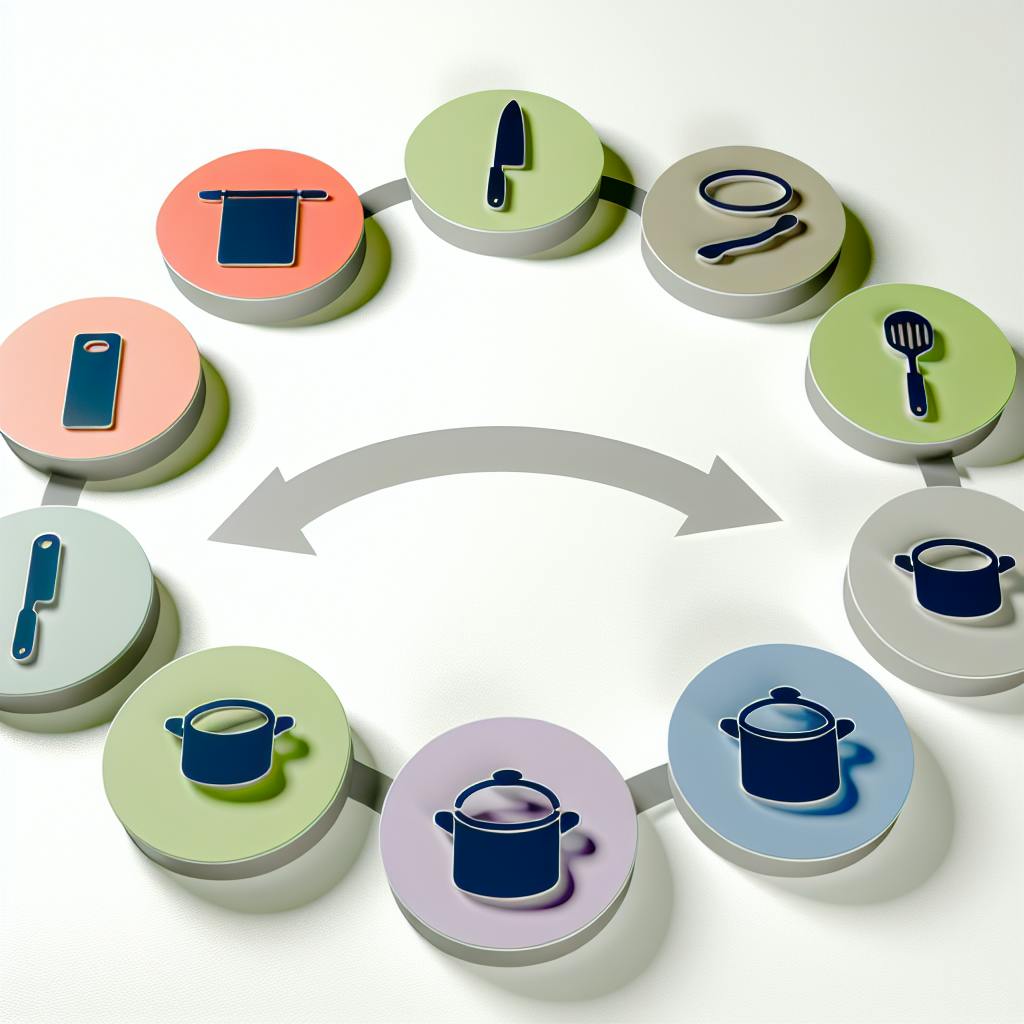Meal kit providers can drive growth by targeting three key demographics:
-
Young Adults (18-29 years)
- Value convenience and variety
- Offer flexible subscriptions, diverse meal options, and easy-to-prepare recipes
-
Health-Conscious Consumers
- Prioritize nutrition and wellness
- Provide high-quality ingredients, transparent labeling, and dietary meal plans (e.g., vegan, gluten-free)
-
Lower-Income Households
- Seek affordable, healthy, and convenient options
- Offer budget-friendly pricing, family-friendly meal kits, and partner with organizations to increase accessibility
To effectively reach these audiences, meal kit companies should:
| Strategy | Description |
|---|---|
| Social Media Engagement | Use platforms like Instagram and TikTok to share recipes, behind-the-scenes content, and partner with influencers |
| Content Marketing | Create educational content (e.g., blog posts, videos) tailored to each demographic's interests and needs |
| Strategic Partnerships | Collaborate with relevant brands, organizations, and influencers to expand reach and credibility |
| Data Analytics | Analyze customer data to identify trends, preferences, and optimize marketing efforts |
| A/B Testing | Test different marketing elements (e.g., email subject lines, ad creatives) to refine strategies |
By understanding and catering to the unique needs of these key demographics through targeted marketing strategies, meal kit providers can drive business growth and stay competitive in the market.
Key Groups for Meal Kit Providers
Meal kit providers can tap into the growing market by understanding the distinct characteristics and preferences of their key customer segments. This section explores the significance of young adults, health-conscious consumers, and lower-income households in the meal kit market.
Young Adults' Meal Kit Preferences
Young adults, particularly those between 18 and 29 years old, are a key demographic driving the meal kit market. They value convenience and flexibility, seeking meal solutions that fit their busy lifestyles.
Key characteristics:
- High incomes and education levels
- Prioritize time-saving and food variety
How meal kit providers can cater to this demographic:
| Offering | Description |
|---|---|
| Convenient delivery options | Flexible subscription plans and delivery schedules |
| Meal variety | Cater to diverse tastes and dietary preferences |
| Easy-to-prepare meals | Minimal cooking skills and time required |
Meeting Health-Conscious Needs
Health-conscious consumers are another key demographic driving the meal kit market. They prioritize healthy eating and nutrition, seeking meal solutions that meet their high standards for wellness.
Key characteristics:
- Prioritize healthy eating and nutrition
- Seek high-quality ingredients and transparent labeling
How meal kit providers can cater to this demographic:
| Offering | Description |
|---|---|
| Nutritious meal options | High-quality ingredients and transparent labeling |
| Meal plans | Cater to specific dietary needs (e.g., vegan, gluten-free, low-carb) |
| Partnerships | Collaborate with health and wellness experts to provide educational resources and support |
Lower-Income Household Requirements
Lower-income households are also an important demographic for meal kit providers. They seek affordable meal solutions that provide healthy and convenient options.
Key characteristics:
- Seek affordable meal solutions
- Prioritize healthy and convenient options
How meal kit providers can cater to this demographic:
| Offering | Description |
|---|---|
| Budget-friendly meal options | Affordable pricing and flexible subscription plans |
| Meal plans | Cater to families with young children, providing healthy and kid-friendly options |
| Partnerships | Collaborate with local food banks and non-profit organizations to provide meal kits to those in need |
By understanding the distinct characteristics and preferences of these key customer segments, meal kit providers can tailor their marketing strategies, product offerings, and customer experiences to drive growth and stay competitive in the market.
Researching Demographic Insights
Meal kit providers need to gather and analyze demographic data to effectively target key demographics. This section outlines the research techniques and tools that meal kit companies can use to understand their target audience.
Using Data Analytics
Data analytics helps meal kit providers understand demographic behaviors and preferences. By analyzing customer data, such as purchase history, browsing patterns, and search queries, meal kit companies can identify trends, preferences, and pain points.
| Data Analytics Insights | Description |
|---|---|
| Age groups | Identify which age groups are most likely to purchase meal kits |
| Meal options | Determine the most popular meal options among different demographics |
| Purchase frequency | Understand how often customers purchase meal kits and what triggers repeat business |
| Marketing channels | Identify the most effective marketing channels for reaching target demographics |
Creating Buyer Personas
Creating buyer personas helps meal kit providers tailor their marketing strategies, product offerings, and customer experiences to specific demographics. A buyer persona is a semi-fictional representation of an ideal customer, based on real data and research.
To create effective buyer personas, meal kit providers should consider the following factors:
- Demographic information: age, income, occupation, etc.
- Psychographic information: values, interests, lifestyle, etc.
- Behavioral information: purchase history, browsing patterns, etc.
- Pain points and challenges
- Goals and aspirations
By creating detailed buyer personas, meal kit providers can develop targeted marketing campaigns that resonate with their target audience, increasing the likelihood of conversion and customer loyalty.
Tailoring Marketing Strategies
Social Media Engagement
Meal kit providers can engage with young adults and health-conscious consumers on social media platforms like Instagram, TikTok, and Pinterest. These platforms allow companies to showcase their meal kits' vibrant colors, fresh ingredients, and creative recipes through eye-catching photos and videos.
Targeting Young Adults
- Use Instagram Reels and TikTok videos to share quick recipe tutorials, behind-the-scenes glimpses, and relatable lifestyle content.
- Partner with influencers and run user-generated content campaigns to build a strong community and foster brand loyalty.
Targeting Health-Conscious Consumers
- Create educational content on nutrition, clean eating, and sustainable sourcing.
- Use Instagram Guides, Pinterest boards, and blog articles to provide valuable information and position the brand as a trusted authority in the health and wellness space.
Connecting Through Content
Content marketing is a powerful tool for educating and engaging targeted demographics. Meal kit companies can create content that addresses the needs and interests of their target audiences.
Content for Young Adults
| Content Type | Description |
|---|---|
| Quick recipe videos | Easy weeknight meals |
| Globally-inspired dishes | Recipes from around the world |
| Meal prep guides | Tips for busy lifestyles |
Content for Health-Conscious Consumers
| Content Type | Description |
|---|---|
| In-depth blog posts | Benefits of various diets (e.g., plant-based, gluten-free) |
| Infographics | Nutritional value of ingredients |
| Expert interviews | Nutritionists or sustainable farmers |
Building Strategic Partnerships
Strategic partnerships can help meal kit companies expand their reach and appeal to diverse demographics.
Partnerships for Lower-Income Households
- Collaborate with local food banks, community organizations, or government assistance programs to make meal kits more accessible and affordable.
Partnerships for Health-Conscious Consumers
- Partner with popular fitness or wellness brands to align the meal kit service with a healthy lifestyle.
- Collaborate on cross-promotional campaigns, co-branded products, or sponsored content to increase visibility and credibility.
Partnerships for Young Adults
- Partner with local restaurants, chefs, or food bloggers to feature guest-curated meal kits or host virtual cooking classes.
- Tap into these influencers' existing followings to enhance the brand's perceived value and authenticity.
sbb-itb-3666cb4
Measuring and Improving Marketing
To ensure the success of your meal kit marketing strategies, it's crucial to track their effectiveness and continually improve them. In this section, we'll discuss the importance of monitoring performance metrics and refining with A/B testing.
Tracking Performance Metrics
To measure the success of your marketing efforts, you need to track key performance indicators (KPIs) that align with your goals. Some essential metrics to monitor include:
| Metric | Description |
|---|---|
| Website traffic | Number of visitors to your website |
| Conversion rate | Percentage of visitors who complete a desired action (e.g., sign up for a newsletter or make a purchase) |
| Customer acquisition cost (CAC) | Cost of acquiring a new customer |
| Customer lifetime value (CLV) | Total value a customer brings to your business over their lifetime |
| Return on investment (ROI) | Revenue generated by a marketing campaign compared to its cost |
Optimizing with A/B Testing
A/B testing, also known as split testing, is a powerful tool for refining your marketing strategies. By testing different elements, such as email subject lines, ad creatives, or landing page designs, you can gather data on what resonates with your target audience and optimize your campaigns for better engagement.
Here's a simple A/B testing framework to follow:
1. Identify a problem: Find an area for improvement in your marketing strategy. 2. Design a test: Create two versions of the marketing element you want to test (e.g., two email subject lines). 3. Run the test: Split your target audience into two groups and show each group one of the test versions. 4. Analyze the results: Compare the performance of both versions and determine which one performs better. 5. Refine your strategy: Implement the winning version and continue testing to further optimize your marketing strategy.
By regularly tracking performance metrics and optimizing with A/B testing, you can ensure your meal kit marketing strategies are effective, efficient, and continually improving.
Conclusion: Growing Meal Kit Business
Meal kit providers can thrive in the competitive market by understanding and targeting key demographics. This article has shown how to use demographic insights to develop effective marketing strategies and cater to the unique needs of young adults, health-conscious consumers, and lower-income households.
Key Takeaways
To grow a successful meal kit business, focus on:
- Young adults: Offer convenient, flexible, and varied meal kits that fit their busy lifestyles.
- Health-conscious consumers: Provide meal kits that cater to their dietary needs and preferences, such as organic, vegan, or gluten-free options.
- Lower-income households: Offer affordable and budget-friendly meal kit options.
Effective Marketing Strategies
To resonate with your target audience, use social media content that speaks to their interests, partner with influencers who align with their values, and offer promotions and discounts that meet their needs.
Stay Ahead of the Competition
By understanding and catering to the diverse needs and preferences of these key demographics, meal kit providers can establish a loyal customer base, drive business growth, and stay ahead of the competition in the meal kit market.
FAQs
What are the demographics of meal kit customers?
Meal kit customers are typically busy professionals, young adults, and families looking for convenient and time-saving meal solutions. They often live in urban and suburban areas and are interested in cooking at home but may not have the time to shop for ingredients.
Demographic Breakdown
| Demographic | Description |
|---|---|
| Age | Millennials and Gen X'ers |
| Income | High-income earners |
| Education | High education levels |
| Occupation | Full-time or self-employed |
| Family | Some have young children under the age of five |
Meal kit customers value time-saving and food variety, making meal kits an attractive option. They are diverse, but they share a common goal of wanting to cook healthy, convenient meals without sacrificing flavor or variety.


